Kingdom Animalia Order Carnivora Family Canidae Scientific name Canis lycaon Higher classification Canis | Phylum Chordata Suborder Caniformia Genus Canis Rank Species | |
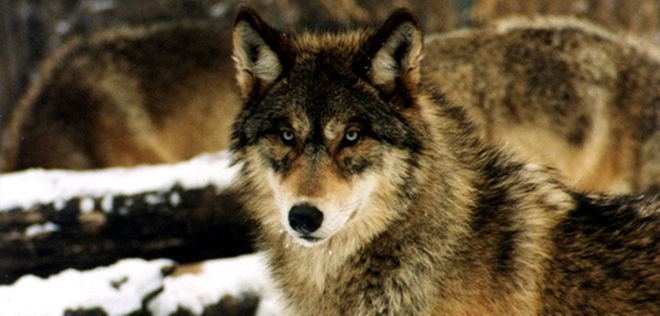 | ||
Similar Canis, Red wolf, Canidae, Arctic wolf, Eurasian wolf | ||
Help protect the eastern wolf
The eastern wolf (Canis lycaon or Canis lupus lycaon), also known as the eastern timber wolf, Algonquin wolf or deer wolf, is a canid native to the northeastern side of North America's Great Lakes region. It is a medium-sized canid which, like the red wolf, is intermediate in size between the coyote and the gray wolf. It primarily preys on white-tailed deer, but may occasionally attack moose and beaver.
Contents
- Help protect the eastern wolf
- Eastern wolf algonquin park
- Taxonomic history and evolution
- Whole genome analysis
- Physical description and behavior
- History hybridization and conservation
- In Algonquin folklore
- Howling
- Attacks on humans
- References
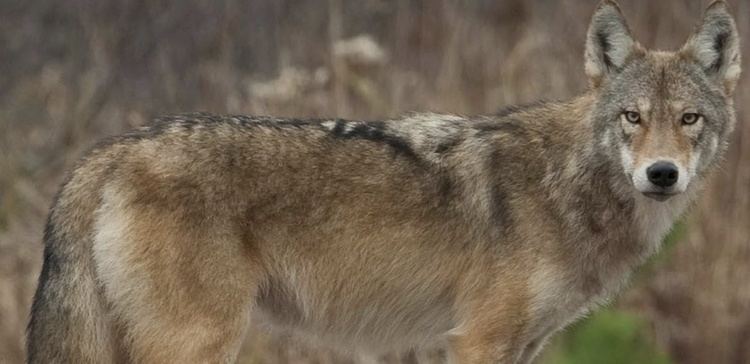
The eastern wolf's taxonomic classification has been under review beginning c. 2000, with various suggestions having been presented as to its derivation, including its being a subspecies of gray wolf, its being conspecific with the red wolf, gray wolf–coyote hybridization, and classification as a separate species within Canis. The eastern wolf is still recognized as a gray wolf subspecies by Mammal Species of the World (as of 2005), but in 2013, following a comprehensive review of several genetic studies, it has been classed as a distinct species by United States Fish and Wildlife Service.
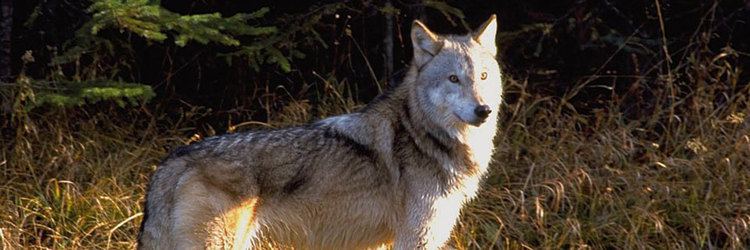
The eastern wolf is currently listed as a threatened species under COSEWIC and with the Committee on the Status of Species at Risk in Ontario (COSSARO), because "new genetic analyses indicate that the eastern wolf is not a subspecies of grey wolf" versus earlier theories that it was a result of hybridization with both gray wolves and coyotes. The eastern wolf is particularly susceptible to hybridization, due to its close relationship to the coyote and its ability to bridge gene flow between both coyotes and gray wolves. Furthermore, human persecution over a period of 400 years caused a population decline which reduced the number of suitable mates, thus facilitating coyote gene swamping into the eastern wolf population. Aside from posing a threat to a unique species, the resulting eastern wolf–coyote hybrids are too small in size to substitute pure eastern wolves as apex predators of moose and deer. The main nucleus of pure eastern wolves is currently concentrated within Algonquin Provincial Park, eastern Ontario and south central Quebec. However, a 2016 study concluded that even these eastern wolves have about 32% coyote ancestry.
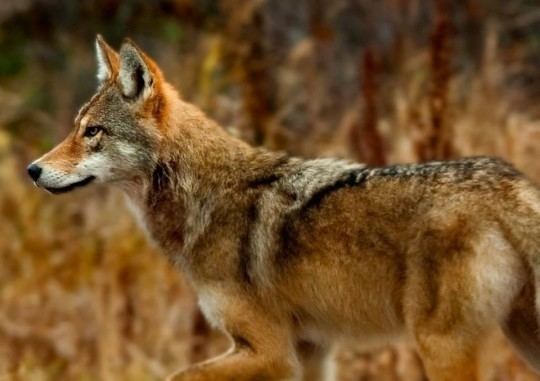
Eastern wolf algonquin park
Taxonomic history and evolution
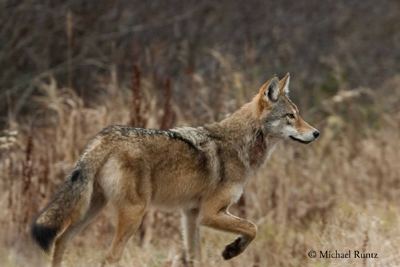
Genetic studies have indicated that the eastern wolf evolved in North America, unlike the gray wolf, which originated in Eurasia, and diverged from a common ancestor with the coyote and red wolf 150,000–300,000 years ago. However, in 2014, the research of Chambers et al. (2012) about the eastern wolf's status as a species became controversial, forcing the USF&WS to commission a peer review of it, known as NCAES (2014). This peer review concluded unanimously that "virtually all taxonomic conclusions from Chambers et al. are accepted uncritically." Two subsequent reviews of updated research in 2013 and 2014, one commissioned to the Wildlife Management Institute by the USFWS, and one journal review, concluded that historically there were four unique canine species in North America, gray wolf, eastern wolf, coyote and dog, and that "the red wolf may be conspecific with the eastern wolf". This view consistent with the idea that the coyote and gray wolf did not historically range into the eastern United States. These reviews and a 2015 genetics study, the most comprehensive to date, led the Committee on the Status of Endangered Wildlife in Canada (COSEWIC) in May, 2015 to change the designation of the eastern wolf to a distinct species, Canis species cf lycaon (Canis species believed to be lycaon). However, the previous assertion that gray wolves did not occur in the eastern third of the United States is still ill-founded by the newer genetic study's lead author Dr. Linda Y. Rutledge who noted in the conclusions that "the recognition of the eastern wolf as a separate species does not exclude the possibility that a grey wolf × eastern wolf hybrid animal (previously identified as Canis lupus lycaon, boreal/Ontario-type), similar to a Great Lakes boreal wolf currently located in the Great Lakes states and across Manitoba, northern Ontario, and northern Quebec, historically inhabited the northeastern United States alongside eastern wolves, and there is some evidence to support the historical presence of both Canis types."
The eastern wolf was first recognized as a distinct species in 1775 by German naturalist Johann Schreber, who termed it loup noir (black wolf). His depiction of the animal however showed it with a black coat, an atypical coloration in eastern wolves. It was later reclassified as a subspecies of gray wolf by Edward Nelson and Goldman. In 2000, the taxonomic status of the eastern wolf was once again brought into question when a genetic study on canids from Algonquin Provincial Park undertaken in Trent University showed that the local wolves bore similarities to red wolves, based on DNA profiles at eight microsatellite loci. Furthermore, sequences were found in both eastern and red wolves that diverged from those of coyotes by 150,000–300,000 years, and no specimens of either species from the 1960s bore any gray wolf mitochondrial DNA. The scientists involved in this study proposed that the eastern and red wolf were the same species, and that the two be combined under the earlier binomial name of C. lycaon. However, this conclusion was disputed, with one study indicating that the eastern wolf is a gray wolf–coyote hybrid and Mammal Species of the World listed it in 2005 as a subspecies of gray wolf.
In May 2011, an analysis of eastern wolf, red wolf, gray wolf, and dog genomes suggested that the wolves of Algonquin Provincial Park are 58% gray wolf and 42% coyote, suggesting that the eastern wolf is a coywolf with more gray wolf content than the red wolf. This study analyzed 48,000 SNP and found no evidence for a unique eastern wolf species. In 2012, re-analysis of the 2011 SNP study argued that the original SNP study suffered from insufficient sampling and noted that gray wolves do not mate with coyotes. Another Y-chromosome genetic study in 2012 also argued that the eastern wolf and red wolf are not hybrids but rather are a distinct species from the gray wolf, although eastern and red wolves do intermix with coyotes. The same authors have argued that the 2011 SNP study finding that eastern wolves are not an independent species is flawed and that historical hunting and culling of wolves, leading to invasion of coyotes into eastern North America, has led to introgression of coyote mitochondrial and nuclear DNA into fragmented, decimated eastern wolf packs. They and other authors have postulated that large populations of eastern and red wolves with intact social/pack structures are less likely to interbreed with coyotes. The controversy over the eastern wolf's species status was the subject of a comprehensive review of the 2011 and 2012 genetics studies, which concluded that there are four separate species of Canis in North America, the eastern wolf, red wolf, gray wolf and coyote.
As of February 2014, an experiment which produced hybrids of coyotes and northwestern gray wolves in captivity using artificial insemination contributed more information to the controversy surrounding the eastern wolf. The six hybrids produced were weighed shortly after birth and were shown to be larger than western coyote pups born around the same time, despite being delivered by a female coyote. However, at six months of age they were weighed again with the two females weighing 17.6 and 21.8 kilograms respectively while the four males were varied between 20.1 and 26.0 kilograms which is close to the average weigh of adult eastern wolves who in turn are around 25 to 30 kilograms. This research suggests that while the eastern wolves are not coywolves, they are still physically similar to such hybrids. Moreover, the FWS review became controversial, forcing the USF&WS to commission a peer review of it, known as NCAES (2014). This peer review concluded unanimously that the review "is not accepted as consensus scientific opinion or best available science".
In 2015, the most comprehensive genetics study, using comprehensive mitochondrial DNA data, Y-chromosome data and genome-wide data from 127,235 SNP, concluded that "the most parsimonious explanation" is that eastern wolves in Algonquin Provincial Park are "a distinct remnant entity of a historical wolf that most likely existed throughout the eastern United States".
The taxonomic reference Mammal Species of the World (2005) does not recognize Canis lycaon, however NCBI/GenBank does list it.
Whole-genome analysis
In 2016, a whole-genome DNA study proposed, based on the assumptions made, that all of the North American wolves and coyotes diverged from a common ancestor less than 6,000–117,000 years ago. The study also indicated that all North America wolves have a significant amount of coyote ancestry and all coyotes some degree of wolf ancestry, and that the red wolf and Great Lakes region wolf are highly admixed with different proportions of gray wolf and coyote ancestry. One test indicated a wolf/coyote divergence time of 51,000 years before present that matched other studies indicating that the extant wolf came into being around this time. Another test indicated that the red wolf diverged from the coyote between 55,000-117,000 years before present and the Great Lakes region wolf 32,000 years before present. Other tests and modelling showed various divergence ranges and the conclusion was a range of less than 6,000 and 117,000 years before present. The study found that coyote ancestry was highest in red wolves from the southeast of the United States and lowest among the Great Lakes region wolves. The theory proposed was that this pattern matched the south to north disappearance of the wolf due to European colonization and its resulting loss of habitat. Bounties led to the extirpation of wolves initially in the south east, and as the wolf population declined wolf-coyote admixture increased. Later, this process occurred in the Great Lakes region with the influx of coyotes replacing wolves, followed by the expansion of coyotes and their hybrids across the wider region. The Great Lakes wolves largely reflect lineages that have descendants in the modern wolf and coyote populations, but also reflect a distinct gray wolf ecotype which may have descendants in the modern wolf populations. The proposed timing of the wolf/coyote divergence conflicts with the finding of a coyote-like specimen in strata dated to 1 million years before present.
In 2016, a study of mitochondrial DNA sequences confirmed the Eastern wolf as a coyote/wolf hybrid.
Physical description and behavior
Charles Darwin described the eastern wolf as being a lightly-built, greyhound-like animal that pursued deer, as opposed to the bulkier, shorter-legged gray wolf. The eastern wolf's fur is typically of a grizzled grayish-brown coloration mixed with cinnamon. The flanks and chest are rufous or creamy, while the nape, shoulder and tail region are a mix of black and gray. Unlike gray wolves, eastern wolves rarely produce melanistic individuals. The first documentend all-black eastern wolf was found to have been an eastern wolf–gray wolf hybrid. Like the red wolf, the eastern wolf is intermediate in size between the coyote and gray wolf, with females weighing 23.9 kilograms (53 lb) on average and males 30.3 kilograms (67 lb). Like the gray wolf, its average lifespan is 3–4 years, with a maximum of 15 years. Their physical sizes that sets them intermediate between gray wolves and coyotes are actually believed to be more related to their adaptations to an environment with predominately medium-sized prey similar to the case with the Mexican wolves in the southern USA rather than their close relationship to red wolves and coyotes.
The eastern wolf primarily targets small to medium-sized prey items like white-tailed deer and beaver, unlike the gray wolf which can effectively hunt large ungulates like caribou, elk, moose and bison. The average territory ranges between 110–185 km², and the earliest age of dispersal for young eastern wolves is 15 weeks, much earlier than gray wolves.
History, hybridization and conservation
Before the arrival of Europeans, eastern wolves may have numbered at 64,500–90,200 individuals. The species ranged throughout the wooded and open areas of eastern North America, from the Maritime provinces and southern Quebec to approximately the southern United States and westward to the Great Plains. The region's indigenous human populations didn't fear eastern wolves, though they did occasionally catch them in traps, and their bones occur in native shell heaps. The earliest written records of the eastern wolf were in the writings of Jacques Cartier in 1535 and in Marc Lescarbot's Histoire de la Nouvelle-France (1609), where he wrote that the animal was common in Acadia.
Early European settlers often kept their livestock on eastern wolf-free outer islands, though animals kept in pasture on the mainland were vulnerable, to the point that a campaign against eastern wolves was launched in the early years of the Plymouth and Massachusetts Bay Colonies, in which both settlers and natives participated. A bounty system was put into effect, offering higher rewards for adult wolves, with their heads exposed on hooks in meetinghouses. Nevertheless, eastern wolves were still plentiful enough by the early 18th century to warrant the settlers of Cape Cod discussing the building of a high fence between Sandwich and Wareham to keep eastern wolves out of grazing lands. The scheme failed, though the settlers continued to utilize wolf pits, a wolf trapping technique learned from the region's indigenous peoples. Eastern wolf numbers declined noticeably shortly before and after the American Revolution, particularly in Connecticut, where the wolf bounty was repealed in 1774. Eastern wolf numbers however were still high enough to cause concern in the more sparsely populated areas of southern New Hampshire and Maine, with wolf hunting becoming a regular occupation among settlers and natives alike. By the early 19th century, few eastern wolves remained in southern New Hampshire and Vermont.
Prior to the establishment of Algonquin Provincial Park in 1893, the eastern wolf was common in central Ontario and the Algonquin Highlands. It continued to persist throughout the late 1800s, despite extensive logging and efforts by park rangers to eliminate it, largely due to the sustaining influence of plentiful prey items like deer and beaver. By the mid-1900s, there were as many as 55 eastern wolf packs in the Park, with an average of 49 wolves being killed annually between 1909–1958, until they were given official protection by the Ontario government in 1959, by which time the eastern wolf population in and around the Park had been reduced to 500–1000 individuals. Nevertheless, between 1964–1965, 36% of the Park's wolf population was culled by researchers trying to understand the reproduction and age structure of the population. This cull coincided with the expansion of coyotes into the park, and lead to an increase in eastern wolf–coyote hybridization. Introgression of gray wolf genes into the eastern wolf population also occurred across northern and eastern Ontario, into Manitoba and Quebec, as well as into the western Great Lakes states of Minnesota, Wisconsin, and Michigan. Despite protection within the Park boundaries, there was a population decline in the east side of the Park between 1987–1999, with an estimated number of 30 packs by 2000. This decline exceeded annual recruitment, and was attributed to human-caused mortality, which mostly occurred when dispersing animals left the Park in search of deer during the winter months, and when pack ranges overlapped with Park boundaries. By 2001, protection was extended to eastern wolves occurring in the outskirts of the Park. By 2012, the genetic composition of the Park's eastern wolves was roughly restored to what it was in the mid-1960s than in the 1980s-1990s, when the majority of wolves had large amounts of coyote DNA.
In Algonquin folklore
The eastern wolf is prominently portrayed in Algonquin mythology, where it is referred to as ma-hei-gan or nah-poo-tee in the Algonquian languages. It is the spirit brother of the Algonquian folkhero Nanabozho, and assisted him in several of his adventures, including thwarting the plots of the malicious anamakqui spirits and assisting him in recreating the world after a worldwide flood.
Howling
Since the discovery in 1963 that eastern wolves answered human imitations of their howls, Algonquin Provincial Park began its Public Wolf Howls attraction, where as many as 2,500 visitors are led on expeditions into areas where eastern wolves were sighted the night before and listen to them answering the Park staff's imitation howls. By 2000, 85 Public Wolf Howls had been held, with over 110,000 people having participated. The Park considers the attraction as the cornerstone of its wolf education program, and credits it with changing public attitudes towards wolves in Ontario.
Attacks on humans
Since the early 1970s, there have been several incidents of bold or aggressive behavior towards humans in Algonquin Provincial Park. Between 1987 and 1996, there were four instances of wolves biting people. The most serious case occurred in 1998, when a male wolf that had been long noted to be unafraid of humans stalked a couple walking their four-year-old daughter in September that year, losing interest when the family took refuge in a trailer. Two days later, the wolf attacked a 19-month-old boy, causing several puncture wounds on his chest and back before being driven off by campers. After the animal was killed later that day, it was found to be non-rabid, and had a DNA profile typical of wolves of the area, thus indicating it was not a hybrid.
